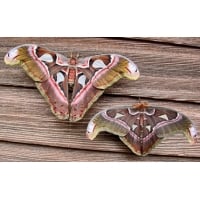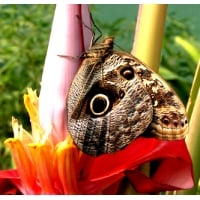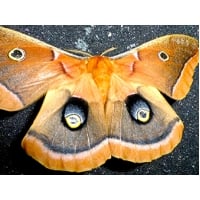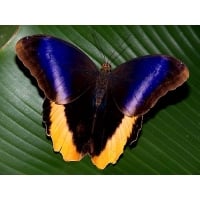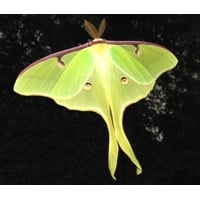CURRENT PUPAE - Chrysalides and cocoons
If you are a beginner and need information on rearing from small caterpillars, or hatching out pupae, please order the All Colour Paperback BUTTERFLIES. INSTRUCTIONS ARE NOT SENT WITH EACH SPECIES, you need to acquire basic skills and this book is a simple way of doing so.
Please Select a Category Below:
Ligurian Emperor Moth Saturnia pavoniella
Slightly larger than our Emperor. A joy to breed: with amazingly varied larvae, quite distinct from Emperor larvae.
Although the moth is similar to our Emperor Moth pavonia, pavoniella male has a paler band on the hindwing inner margin. There are other differences in appearance and the intensity of pattern, particularly in the male.
Large larvae are quite distinct from those of pavonia, and very diverse in their colouring (see pictures). Foodplants are the same as for pavonia and include Apple, Plum, Blackthorn, Bramble, Hawthorn, Heather, Willow, Birch, and many others. Pavoniella females pair several times (pavonia only once). The two species hybridise easily but the progeny of hybrids of pavonia with pavoniella are infertile, which indicates that pavoniella is a true species. Pavoniella is found in central Europe, extending south to Greece and for some distance into Turkey and well into Asia Minor.
Pairing is very easy in sunshine. Rearing the larvae is most rewarding and interesting. Do give this species a try!
Giant Atlas Moth Attacus atlas
Atlas cocoons have become very difficult to obtain, particularly the dormant Thailand race, but we expect to have them again this winter.
The largest moth in the world. Winter cocoons are dormant. You can choose whether to incubate them or keep them cold until the spring. To get them to emerge, raise the temperature to 15 degrees C, and gradually up to 30 degrees C or more, and very humid. They need very warm and humid tropical conditions. When hot, soak the cocoons at least once or twice daily.
It is probably better to keep them cool (8 -12 degrees C) and dormant until mid-April, or even May, then raise the temperature and humidity as described above. They will respond better to summer conditions.
Pairing is achieved in a cage that is ample for the size of the moths but not so large that they can become too separated.
Larvae feed on Privet Ligustrum and are easily reared in warm and moist conditions. Atlas larvae will also feed on Tree of Heaven Ailanthus, Osier Willow Salix viminalis, Citrus and undoubtedly a number of other substitute plants outside their normal habitat.
Attacus lorquinii - Philippines
This species, endemic to the Philippines, is characterised by the prominent red lines and markings across the wings.
You can choose whether to incubate them or keep them cold until the spring. To get them to emerge, raise the temperature to 15 degrees C, and gradually up to 30 degrees C or more, and very humid. They need very warm and humid tropical conditions. When hot, soak the cocoons at least once or twice daily.
It is probably better to keep them cool (8 -12 degrees C) and dormant until mid-April, or even May, then raise the temperature and humidity as described above. They will respond better to summer conditions.
Pairing is achieved in a cage that is ample for the size of the moths but not so large that they can become too separated.The larvae feed on Privet. They appreciate humidity and a temperature of at least 25 degrees C.
Owl Butterfly Caligo pupae South America
By any standards, these are huge butterflies, with impressive colouring and markings, both on the upperside and with the owl-like underside. The pupae will be unspecified species but will all produce magnificent and breath-taking butterflies.
Owl Butterflies fly at dusk and dawn in particular, so they like low light conditions.
The pupae are massive, pretty well as big as any other in the world. They are naturally formed on Banana trees, which are the foodplant of the larvae, and they resemble the spent and decaying banana fronds around the trunk. Hang the pupae in an emerging cage, out of the sun, but in warm and moist conditions. A greenhouse is ideal. Let the butterflies feed on dishes of rotting fruit and do include banana, which they really love.
Provide warmth and humidity that the pupae normally experience in the tropics and sub tropics. About 30°C is ideal, and humidity above 70%. The butterflies like a warm greenhouse containing nectar plants, and this is the best place also for the emerging cage for the pupae. Shade the cage from direct sun which is too harsh.
It’s a good idea to suspend the pupae. To do this, use a stick or wooden rod held horizontally. Apply a very thin line of contact adhesive eg Evostick along the rod. Lay the rod on a table and, when it is tacky but not yet set hard, touch the tails of the pupae on the line of glue. Warning: excess glue actually kills the pupa, so use just a very thin line. When the glue has set you can pick up the stick, with all the pupae hanging vertically from it.
If you don’t wish to suspend the pupae they can be laid on corrugated card. The surface must remain clean and rough. For hygiene the corrugated card needs to be replaced every few days.
American Oak Silkmoth Antheraea polyphemus
The hindwings of both sexes have huge target eyespots. Pairing sometimes easy, other times changes of setup are needed. The female lays a large number of eggs.
The larvae are easy to rear on Oak or Osier Willow. Along the sides of larger larvae there are silver spangles, like drops of mercury. Lovely larvae to rear.
They are also reported to feed on Hawthorn,Oak, Birch, Willow, Sallow, Maple, Apple, Cherry, Alder, Elm. Also try Walnut, Pseudacacia, Sumac Rhus typhina.
Owl Butterfly Caligo atreus pupae
This is one of the largest South American butterflies and magnificently coloured, on a par with Morphos for impressiveness and beauty.
The underside not only has the characteristic huge owl eye markings, but it is uniquely patterned with complicated cream areas.
Like Morpho butterflies, the Owl species are crepuscular, flying mainly at dusk and dawn. They feed avidly from rotting fruit. If you are lucky enough to have a tropical greenhouse you can expect these to breed in the presence of the larval foodplant, Banana trees. If you don't have such conditions you might be lucky in these warm conditions if you use a large cage with potted banana plants.
Owl Butterfly pupae are vast - at least the size of the Birdwing pupae - and they resemble folded decaying leaves of the Banana tree, on which the larvae have been feeding. Suspend the pupae from the tail, in suitably warm, shaded and moist conditions, sit back and await one of the greatest experiences of nature!
American Moon Moth Actias luna North America
A very attractive Moon Moth that emerges from May and breeds exceptionally easily. The larvae feed well on Walnut, Birch, Osier Willow, Liquidambar, Plane, Maples, Aspen, Plum, Sallow, Several kinds of Oak and maybe other foodplants.
A second brood is produced in late summer. Winter is passed in the cocoon stage. Store them cold from November until April. May is the normal emergence time for the first brood.



